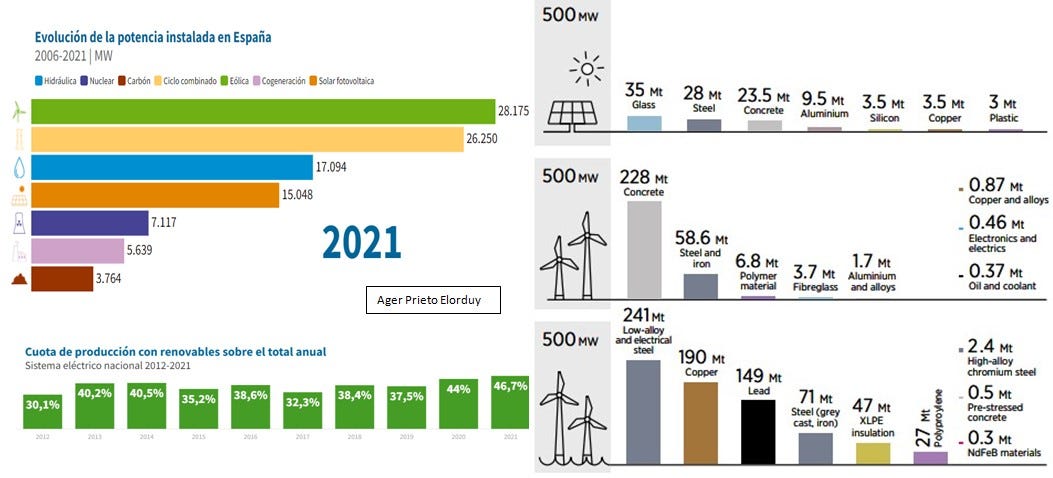17) El elefante en la habitación del que nadie quiere hablar
Para avanzar hacia un mundo más sostenible se pueden discernir 2 grandes pilares que sustentarán las sociedades del futuro. El primero y más evidente es reducir el uso de combustibles fósiles para minimizar el impacto en el medio ambiente. Estrechamente ligado a esto, esta la penetración de las energías renovables como método alternativo y limpio a la hora de producir energía.
Según Red Eléctrica Española en 2021 las tecnologías renovables continuaron su crecimiento en el parque generador del país, representando 56,6% de la capacidad verde de producción nacional. La tecnología con mayor potencia instalada en 2021 de España fue la eólica con un 25%, seguido del ciclo combinado con 23,3%, la hidráulica 15,1% y la solar fotovoltaica 13,3%.
Pero en esta tesitura, todos tenemos claro que las energías renovables tienen un menor impacto directo a la hora de generar la energía, pero aguas arriba es una energía tan limpia como parece?
Las CRM (Critical Raw Materials) son indispensables para las renovables, por resaltar algunos con una importancia capital son el cobre , el níquel, el litio y los REE (rare earth elements), especialmente el neodimio y disprosio. El cobre es un componente crucial de las líneas eléctricas que conectan los generadores con los usuarios finales. El litio y el níquel se utilizan para producir baterías recargables. Neodimio y disprosio juegan un papel clave en los imanes permanentes que se encuentran en las turbinas eólicas y los vehículos eléctricos. Ninguno de estos elementos puede ser fácilmente reemplazado por alternativas.
En la imagen adjunta podréis observar la ingente cantidad de materiales que son necesarios para montar una instalación renovable de 500 MW (solar / eólica on y off-shore).
En uno de los últimos informe de International Renewable Energy Agency (IRENA) indica lo siguiente: “El escenario de 1,5 °C propone que las renovables constituyan el 90 % de la combinación energética para 2050, un cambio que aumentaría la capacidad instalada de renovables x10 de 2.800 GW en 2020 a 27.700 GW en 2050.”
En el inicio del post he mencionado 2 pilares, siendo el segundo 𝐥𝐚 𝐞𝐟𝐢𝐜𝐢𝐞𝐧𝐜𝐢𝐚 𝐞𝐧𝐞𝐫𝐠é𝐭𝐢𝐜𝐚 𝐲 𝐞𝐥 𝐜𝐨𝐧𝐬𝐮𝐦𝐨 𝐞𝐧𝐞𝐫𝐠é𝐭𝐢𝐜𝐨 𝐬𝐨𝐬𝐭𝐞𝐧𝐢𝐛𝐥𝐞. En este apartado entra la conciencia propia de cada individuo, como manifiesta Antonio Turiel Martínez en una entrevista reciente “Uno de los problemas que tenemos en la sociedad actual es la obsolescencia programada: las cosas tienen que durar un tiempo y luego te las tienes que quitar de encima para que la fábrica pueda seguir vendiendo. Este modelo de consumo, te lleva a una economía de estado estacionario y no a una economía creciente. Entra en una contradicción flagrante con el sistema capitalista que se basa en el crecimiento infinito de un planeta finito. Y aquí está el problema”.
17) The elephant in the room that no one wants to talk about
In order to move towards a more sustainable world, 2 main pillars can be discerned that will sustain the societies of the future. The first and most obvious is to reduce the use of fossil fuels to minimize the impact on the environment. Closely linked to this is the penetration of renewable energies as an alternative and clean method of producing energy.
According to Red Eléctrica Española, in 2021 renewable technologies continued their growth in the country's generating park, representing 56.6% of the national green production capacity. The technology with the highest installed power in Spain in 2021 was wind power with 25%, followed by the combined cycle with 23.3%, hydraulics 15.1% and solar photovoltaic 13.3%.
But in this situation, we are all clear that renewable energies have less direct impact when it comes to generating energy, but is upstream energy as clean as it seems?
CRM (Critical Raw Materials) are essential for renewables, to highlight some of capital importance are copper, nickel, lithium and REE (rare earth elements), especially neodymium and dysprosium. Copper is a crucial component of the power lines that connect generators to end users. Lithium and nickel are used to produce rechargeable batteries. Neodymium and dysprosium play key roles in the permanent magnets found in wind turbines and electric vehicles. None of these elements can be easily replaced by alternatives.
In the attached image you can see the huge amount of materials that are necessary to assemble a 500 MW renewable installation (solar / wind on and off-shore).
In one of the latest reports from the International Renewable Energy Agency (IRENA) it indicates the following: “The 1.5 °C scenario proposes that renewables make up 90% of the energy mix by 2050, a change that would increase the installed capacity of renewables x10 from 2,800 GW in 2020 to 27,700 GW in 2050.”
At the beginning of the post I mentioned 2 pillars, the second being energy efficiency and sustainable energy consumption. Each individual's own conscience enters this section, as Antonio Turiel Martínez stated in a recent interview "One of the problems we have in today's society is planned obsolescence: things have to last for a while and then you have to take them off above so that the factory can continue selling. This consumption model takes you to a steady state economy and not to a growing economy. It enters into a flagrant contradiction with the capitalist system that is based on the infinite growth of a finite planet. And here is the problem".






